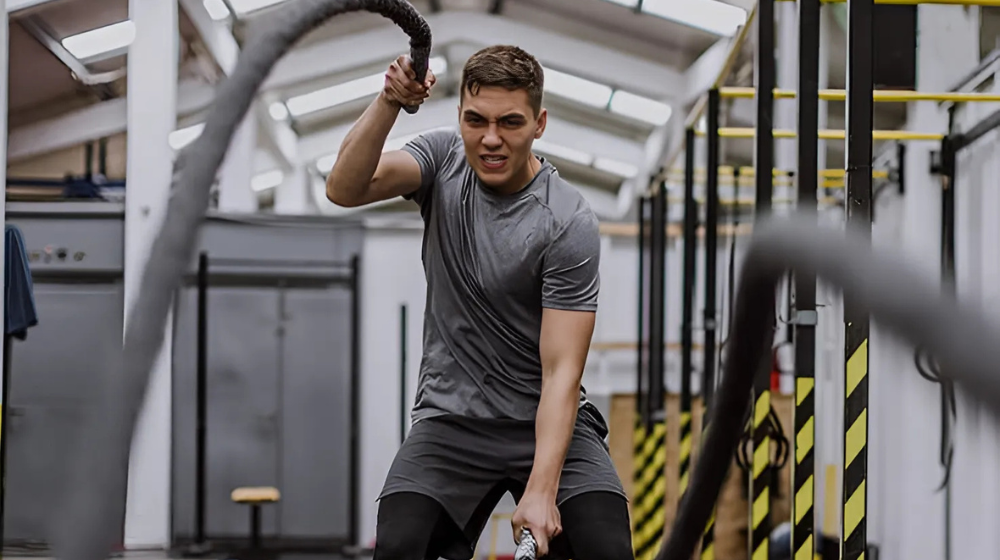Cross-Training Benefits and How to Start – Boost fitness, prevent injuries, and improve performance with a variety of workouts.
Introduction
In the world of fitness, sticking to a single workout routine can sometimes lead to boredom, plateaus, or even injury. This is where cross-training comes in—a versatile approach that combines various types of exercises to create a more balanced, engaging, and effective fitness regimen. Whether you’re a seasoned athlete or just starting your fitness journey, cross-training offers a way to challenge your body, enhance performance, and keep things exciting. In this blog post, we’ll explore the many benefits of cross-training, from improving overall fitness and reducing the risk of injury to preventing workout monotony.
What is Cross-Training?

A Versatile Approach to Fitness
Cross-training is a fitness strategy that involves combining various exercises and workout styles into your routine. Instead of focusing on just one activity, such as running or weightlifting, it blends multiple types of physical activities to enhance overall fitness and performance.
How Cross-Training Works
The idea behind cross-training is to engage different muscle groups and challenge your body in diverse ways. For example:
- A runner might incorporate swimming or yoga to improve flexibility and reduce impact stress.
- A weightlifter might add cycling or HIIT for better cardiovascular health.
The Goal of Cross-Training
Cross-training ensures that no single part of the body is overworked while addressing fitness gaps. This balanced approach not only boosts performance but also reduces the risk of injuries and helps break workout monotony.
Benefits of Cross-Training {1}
Improved Overall Fitness
Cross-training targets different muscle groups and incorporates various physical skills, such as strength, endurance, flexibility, and balance. This leads to a more well-rounded fitness profile, allowing you to excel in multiple areas rather than focusing on just one.
Reduced Risk of Injury
By varying your workouts, you reduce the repetitive stress placed on specific muscles and joints. This lowers the risk of overuse injuries and provides your body with time to recover while staying active.
Enhanced Performance in Your Primary Activity
Engaging in complementary exercises can improve your performance in your main sport or activity. For instance, strength training can enhance a runner’s power, while yoga can increase a weightlifter’s flexibility and mobility.
Increased Workout Variety
Switching between different types of exercises keeps your fitness routine exciting and prevents boredom. A varied workout plan can also boost motivation, making it easier to stick to your goals.
Breakthrough Fitness Plateaus
If you’ve hit a plateau in your fitness journey, cross-training can help you push past it. New activities challenge your body in unique ways, stimulating muscle growth and improving cardiovascular endurance.
Enhanced Recovery
Low-impact cross-training activities, such as swimming or yoga, provide active recovery options. These exercises keep you moving while allowing your body to heal and rejuvenate.
Adaptability to Different Environments
Cross-training prepares you for various physical activities and conditions. Whether you’re training indoors, outdoors, or with limited equipment, the versatility of cross-training ensures you can maintain your fitness routine.
How to Get Started with Cross-Training
Assess Your Fitness Goals
Before diving into cross-training, identify your primary fitness objectives. Are you looking to improve endurance, build strength, enhance flexibility, or prevent injuries? Understanding your goals will help you choose the right mix of activities.
Choose Complementary Activities
Select exercises that complement your primary workout. For example:

- Runners: Add strength training and yoga to improve muscle stability and flexibility.
- Weightlifters: Incorporate cardio or swimming to boost heart health.
- Cyclists: Try Pilates or resistance training for core strength and overall balance.
Start Gradually
Introduce one or two new activities into your routine. Gradually increase their intensity and frequency to avoid overloading your body.
Create a Balanced Weekly Plan
Design a schedule that includes a mix of cardio, strength training, and flexibility exercises. For example:
- Monday: Strength training
- Wednesday: Swimming
- Friday: Yoga or Pilates
- Saturday: Cycling or running
Listen to Your Body
Pay attention to how your body responds to different activities. If you feel soreness or discomfort, adjust the intensity or type of exercise. Rest days are equally important for recovery and preventing burnout.
Use Proper Equipment and Technique
Ensure you have the appropriate gear for each activity, such as supportive running shoes or a yoga mat. Learning the correct form for new exercises can prevent injuries and improve results.
Consider Professional Guidance
If you’re unsure where to start, seek advice from a personal trainer or fitness coach. They can help you design a personalized cross-training program that aligns with your goals and fitness level.
Track Your Progress
Keep a fitness journal or use an app to monitor your workouts. Tracking your progress will help you stay motivated and identify areas for improvement.
Balanced Diet plan for Cross-Training
A diet for cross-training should be well-balanced, providing the necessary nutrients to support energy levels, muscle recovery, and overall health. Here’s a guide to creating a diet plan tailored for cross-training:
Prioritize Macronutrients
Carbohydrates
- Carbs are your primary energy source for high-intensity workouts.
- Include complex carbs like whole grains, oats, quinoa, sweet potatoes, and legumes.
- Add simple carbs (like fruits or honey) before or after workouts for quick energy.
Proteins
- Protein is crucial for muscle repair and recovery.
- Include lean sources such as chicken, turkey, fish, eggs, tofu, lentils, and low-fat dairy.
- Aim for 1.2–2.0 grams of protein per kilogram of body weight daily, depending on your intensity level.
Fats
- Healthy fats support joint health, hormone production, and sustained energy.
- Opt for avocados, nuts, seeds, olive oil, and fatty fish like salmon.
Hydration is Key
- Stay hydrated by drinking water throughout the day.
- During intense or long-duration sessions, consider electrolyte drinks to replenish sodium, potassium, and magnesium.
Timing Your Meals
Pre-Workout Meal (1-3 hours before training)
- Focus on a mix of carbs and protein to fuel your workout.
- Example: Whole grain toast with almond butter and banana slices, or oatmeal with berries and a protein shake.
Post-Workout Meal (Within 30-60 minutes after training)
- Combine protein and carbs to aid muscle recovery and replenish glycogen.
- Example: Grilled chicken with quinoa and steamed vegetables, or a smoothie with protein powder, spinach, and a banana.
Include Micronutrients
- Iron: For energy and oxygen delivery (found in spinach, red meat, and beans).
- Calcium and Vitamin D: For bone health (found in dairy, fortified plant milk, and leafy greens).
- Magnesium: For muscle function and recovery (found in nuts, seeds, and whole grains).
- Antioxidants: To reduce inflammation (found in berries, citrus fruits, and dark chocolate).
Daily Diet Example for Cross-Training
Breakfast
- Scrambled eggs with spinach and whole-grain toast.
- A small orange or kiwi.
Mid-Morning Snack
- Greek yogurt with a handful of mixed nuts.
Lunch
- Grilled salmon, quinoa, and steamed broccoli.
- A side salad with olive oil and balsamic dressing.
Afternoon Snack
- Apple slices with almond butter or hummus with carrot sticks.
Dinner
- Lean turkey or tofu stir-fry with brown rice and mixed vegetables.
- A small sweet potato on the side.
Evening Snack (Optional)
- Cottage cheese with a drizzle of honey or a protein shake if needed.
Adjust Based on Activity
- On high-intensity days: Increase your carb intake to fuel performance.
- On rest or light activity days: Focus more on protein and fats while slightly reducing carbs.
Cross-Training Diet Plan
| Meal/Time | Food/Drink | Macronutrient Focus | Sample Serving Size | Examples |
|---|---|---|---|---|
| Breakfast | Scrambled eggs, whole-grain toast, spinach | Carbs, Protein, Healthy Fats | 2 eggs, 1 slice toast, 1 cup spinach | Egg & veggie scramble with avocado on the side. |
| Mid-Morning Snack | Greek yogurt with mixed nuts | Protein, Healthy Fats | ½ cup yogurt, 10 almonds | Greek yogurt parfait with nuts and berries. |
| Lunch | Grilled salmon, quinoa, steamed broccoli | Protein, Complex Carbs, Veggies | 4 oz salmon, ½ cup quinoa, 1 cup broccoli | Salmon bowl with quinoa and vegetables. |
| Afternoon Snack | Apple slices with almond butter | Carbs, Healthy Fats | 1 apple, 1 tbsp almond butter | Apple slices with nut butter for a quick boost. |
| Dinner | Turkey stir-fry with brown rice and vegetables | Protein, Complex Carbs, Vegetables | 4 oz turkey, ½ cup brown rice, 1 cup veggies | Stir-fry with lean meat and whole grains. |
| Evening Snack | Cottage cheese with honey | Protein, Healthy Fats | ½ cup cottage cheese, 1 tsp honey | Cottage cheese with honey for nighttime recovery. |
Hydration & Micronutrients
- Hydration: Aim for 8-10 cups of water daily. Adjust based on workout intensity and duration.
- Electrolytes: Include electrolytes post-workout through drinks like coconut water or a sports drink.
Examples of Cross-Training Workouts
Runner’s Cross-Training Workout
- Activity: Running
- Cross-Training Exercises:
- Strength Training: Lower body (e.g., squats, lunges, deadlifts) – 3 sets of 10-12 reps
- Core Work: Planks, twists – 3 sets of 30 seconds each
- Swimming: 500 meters at a steady pace
- Flexibility: Dynamic stretching or yoga (e.g., pigeon pose, warrior stretches) – 15 minutes
2. Cyclist’s Cross-Training Workout

- Activity: Cycling
- Cross-Training Exercises:
- Strength Training: Upper body (e.g., push-ups, pull-ups, shoulder presses) – 3 sets of 10-12 reps
- HIIT Cardio: 30 seconds sprint, 1-minute walk (repeat 5 times)
- Pilates: Focus on core stability – 3 sets of 15-20 reps
- Foam Rolling & Stretching – 10-15 minutes
3. Swimmer’s Cross-Training Workout
- Activity: Swimming
- Cross-Training Exercises:
- Strength Training: Full-body exercises (e.g., rows, pull-ups, deadlifts) – 3 sets of 8-10 reps
- HIIT Cycling: 20-minute interval ride (alternate between high resistance and recovery)
- Mobility Exercises: Dynamic stretches (e.g., leg swings, arm circles) – 10-15 minutes
- Recovery: Foam rolling and light yoga – 15 minutes
4. Weightlifter’s Cross-Training Workout
- Activity: Weightlifting
- Cross-Training Exercises:
- Cardio: 20-30 minute steady-state run or rowing
- Yoga: Focus on flexibility and mobility (e.g., downward dog, pigeon pose) – 15 minutes
- HIIT Sprints: 30 seconds sprint, 1-minute walk – 4 rounds
- Resistance Band Work: Shoulder stability exercises – 3 sets of 10 reps
5. General Cross-Training Workout
- Activity: Mixed
- Cross-Training Exercises:
- Cardio: 20-minute circuit (e.g., 2-minute jump rope, 3-minute cycling)
- Strength Training: Full-body circuit (e.g., squats, push-ups, rows) – 3 rounds of 15-20 reps
- Flexibility: Foam rolling and static stretching – 10-15 minutes
- Core Work: Plank variations – 3 sets of 30 seconds
Common Mistakes to Avoid
When engaging in cross-training, it’s easy to fall into common pitfalls that can hinder progress or lead to injury. Here are some common mistakes to avoid:
Ignoring Proper Warm-Up and Cool-Down
- Mistake: Skipping warm-ups or cool-downs.
- Why to Avoid: Failing to properly warm up increases the risk of injury, while neglecting cool-down can result in delayed muscle soreness and reduced flexibility.
- Solution: Always start with dynamic stretches and end with static stretching or foam rolling.
Overloading Too Quickly
- Mistake: Adding too many cross-training activities at once or increasing intensity too quickly.
- Why to Avoid: Sudden increases in workload can lead to burnout or overuse injuries.
- Solution: Gradually introduce new activities and increase intensity over time (e.g., 10% increase per week).
Ignoring Individual Fitness Levels
- Mistake: Assuming the same routine works for everyone.
- Why to Avoid: Cross-training should be tailored to individual fitness levels, as not all exercises suit everyone’s abilities.
- Solution: Customize workouts based on your current fitness, experience, and goals.
Not Fueling Your Body Adequately
- Mistake: Skipping meals or not eating enough to support physical demands.
- Why to Avoid: Inadequate nutrition impairs recovery, energy levels, and performance.
- Solution: Ensure a balanced diet with the right macronutrients (carbs, proteins, fats) for energy and muscle repair.
Neglecting Rest and Recovery
- Mistake: Overtraining and not allowing for proper recovery.
- Why to Avoid: Constant exercise without adequate rest increases the risk of injury and leads to burnout.
- Solution: Include rest days, listen to your body, and ensure a balanced workout schedule.
Poor Exercise Form and Technique
- Mistake: Performing exercises with improper form to meet higher reps or weights.
- Why to Avoid: Poor form can lead to muscle imbalances, joint stress, and injuries.
- Solution: Focus on mastering the basics with proper technique, and seek guidance if needed.
Ignoring Flexibility and Mobility
- Mistake: Focusing solely on strength and cardio without improving flexibility and mobility.
- Why to Avoid: Reduced flexibility can lead to restricted movements and increased risk of injuries, especially in dynamic sports.
- Solution: Regularly incorporate stretching, yoga, or mobility exercises into your routine.
Failing to Monitor Progress
- Mistake: Not tracking progress in workouts or failing to adjust routines accordingly.
- Why to Avoid: Without tracking, you won’t know what is working or where improvements are needed.
- Solution: Keep a workout journal or use fitness apps to track performance and progress over time.
Conclusion
Cross-training is a versatile and effective approach to fitness that offers numerous benefits for both physical performance and overall health. By incorporating a variety of activities into your routine—such as strength training, cardio, flexibility exercises, and low-impact activities—you can improve your overall fitness, reduce the risk of injury, and maintain long-term motivation.
Cross-training ensures a well-rounded approach to fitness, targeting multiple muscle groups and fitness areas. It helps improve balance and coordination, providing a more comprehensive workout.
By varying exercises, you reduce repetitive stress and avoid overuse injuries. Complementary activities improve specific areas like strength, endurance, and flexibility, which directly benefit your primary sport or activity.
FAQs about Cross-Training
What is cross-training?
Cross-training involves engaging in various types of exercises to improve overall fitness and avoid overuse injuries.
Why is cross-training important?
It improves balance, reduces the risk of injury, boosts overall fitness, and keeps workouts diverse and engaging.
Who can benefit from cross-training?
Anyone, from athletes to beginners, can benefit from cross-training to enhance performance and avoid burnout.
Can cross-training help with weight loss?
Yes, cross-training combines different workouts that burn calories effectively and help in weight management.
How often should I cross-train?
It depends on your fitness level, but a balanced routine of 2-3 cross-training sessions per week is a good starting point.
What types of activities are included in cross-training?
Activities can include running, swimming, cycling, strength training, yoga, pilates, and more.
Is cross-training suitable for beginners?
Yes, beginners can start with lower-intensity activities and gradually increase the variety and intensity.
How does cross-training prevent injuries?
By working different muscle groups and avoiding repetitive movements, cross-training reduces the risk of overuse injuries.
What is the best way to incorporate cross-training into my routine?
Mix different exercises throughout the week, ensuring a balance between cardio, strength, flexibility, and low-impact activities.
How do I choose the right cross-training activities?
Choose activities that complement your primary sport or fitness goal, and consider your fitness level and preferences.
Can cross-training improve athletic performance?
Yes, by strengthening muscles, improving endurance, and enhancing flexibility, cross-training can significantly improve athletic performance.
What are some low-impact cross-training activities?
Activities like swimming, cycling, rowing, and yoga are great for low-impact cross-training.
What should I eat after cross-training?
A balanced post-workout meal or snack with protein and carbs is ideal for muscle recovery, such as a smoothie or grilled chicken with sweet potatoes.
How do I prevent burnout from cross-training?
Maintain a variety of exercises, listen to your body, and ensure proper recovery with rest days.
What are the best cross-training exercises for cardio?
Running, swimming, cycling, and high-intensity interval training (HIIT) are great cardio cross-training options.
Can cross-training improve mental health?
Yes, the variety of exercises can reduce stress, improve mood, and boost overall mental well-being.
Should I always cross-train at high intensity?
No, it’s important to vary intensity, incorporating both high-intensity and low-intensity sessions for balanced fitness.
Is it necessary to have a specific workout plan for cross-training?
While a structured plan is helpful, it’s not mandatory. However, a balanced routine ensures consistency and progress.
How do I track progress in cross-training?
Use a fitness journal or apps to track workouts, progress, and changes in performance over time.
By healthylyfe


